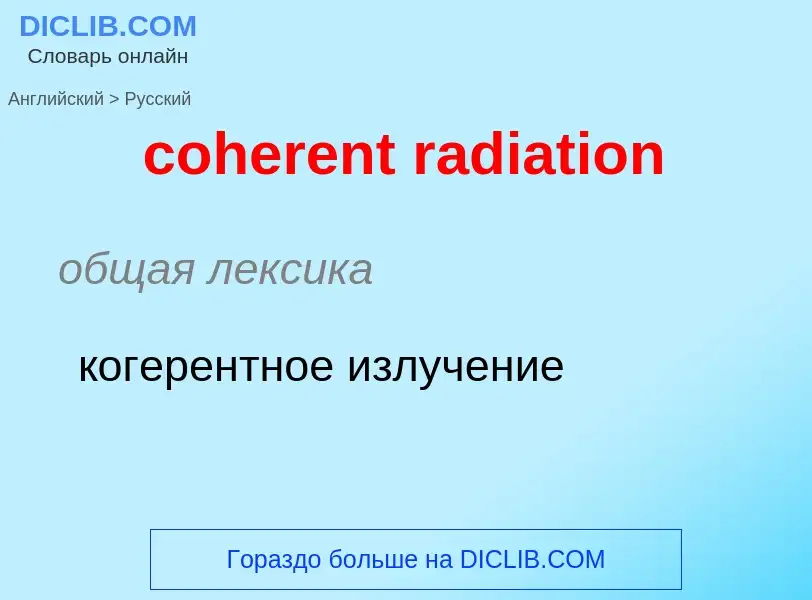Translation and analysis of words by ChatGPT artificial intelligence
On this page you can get a detailed analysis of a word or phrase, produced by the best artificial intelligence technology to date:
- how the word is used
- frequency of use
- it is used more often in oral or written speech
- word translation options
- usage examples (several phrases with translation)
- etymology
coherent radiation - translation to russian
общая лексика
когерентное излучение
Definition
Wikipedia
A laser is a device that emits light through a process of optical amplification based on the stimulated emission of electromagnetic radiation. The word laser is an anacronym that originated as an acronym for light amplification by stimulated emission of radiation. The first laser was built in 1960 by Theodore Maiman at Hughes Research Laboratories, based on theoretical work by Charles H. Townes and Arthur Leonard Schawlow.
A laser differs from other sources of light in that it emits light that is coherent. Spatial coherence allows a laser to be focused to a tight spot, enabling applications such as laser cutting and lithography. Spatial coherence also allows a laser beam to stay narrow over great distances (collimation), enabling applications such as laser pointers and lidar (light detection and ranging). Lasers can also have high temporal coherence, which allows them to emit light with a very narrow spectrum. Alternatively, temporal coherence can be used to produce ultrashort pulses of light with a broad spectrum but durations as short as a femtosecond.
Lasers are used in optical disc drives, laser printers, barcode scanners, DNA sequencing instruments, fiber-optic, and free-space optical communication, semiconducting chip manufacturing (photolithography), laser surgery and skin treatments, cutting and welding materials, military and law enforcement devices for marking targets and measuring range and speed, and in laser lighting displays for entertainment. Semiconductor lasers in the blue to near-UV have also been used in place of light-emitting diodes (LEDs) to excite fluorescence as a white light source. This permits a much smaller emitting area due to the much greater radiance of a laser and avoids the droop suffered by LEDs; such devices are already used in some car headlamps.

![Aleksandr Prokhorov]] Aleksandr Prokhorov]]](https://commons.wikimedia.org/wiki/Special:FilePath/Aleksandr Prokhorov.jpg?width=200)
![[[Charles H. Townes]] [[Charles H. Townes]]](https://commons.wikimedia.org/wiki/Special:FilePath/Charles Townes.jpg?width=200)
![Close-up of a table-top dye laser based on [[Rhodamine 6G]] Close-up of a table-top dye laser based on [[Rhodamine 6G]]](https://commons.wikimedia.org/wiki/Special:FilePath/Coherent 899 dye laser.jpg?width=200)
![CD]] or [[DVD player]] CD]] or [[DVD player]]](https://commons.wikimedia.org/wiki/Special:FilePath/Diode laser.jpg?width=200)
![The free-electron laser ''FELIX'' at the FOM Institute for Plasma Physics Rijnhuizen, [[Nieuwegein]] The free-electron laser ''FELIX'' at the FOM Institute for Plasma Physics Rijnhuizen, [[Nieuwegein]]](https://commons.wikimedia.org/wiki/Special:FilePath/FELIX.jpg?width=200)
!['''LASER notebook:''' First page of the notebook wherein [[Gordon Gould]] coined the acronym LASER, and described the elements required to construct one. Manuscript text: "Some rough calculations on the feasibility / of a LASER: Light Amplification by Stimulated / Emission of Radiation. /
Conceive a tube terminated by optically flat / [Sketch of a tube] / partially reflecting parallel mirrors..." '''LASER notebook:''' First page of the notebook wherein [[Gordon Gould]] coined the acronym LASER, and described the elements required to construct one. Manuscript text: "Some rough calculations on the feasibility / of a LASER: Light Amplification by Stimulated / Emission of Radiation. /
Conceive a tube terminated by optically flat / [Sketch of a tube] / partially reflecting parallel mirrors..."](https://commons.wikimedia.org/wiki/Special:FilePath/Gould notebook 001.jpg?width=200)
![Lasers range in size from microscopic [[diode laser]]s (''top'') with numerous applications, to football field sized [[neodymium]] glass lasers (bottom) used for [[inertial confinement fusion]], [[nuclear weapon]]s research and other high energy density physics experiments Lasers range in size from microscopic [[diode laser]]s (''top'') with numerous applications, to football field sized [[neodymium]] glass lasers (bottom) used for [[inertial confinement fusion]], [[nuclear weapon]]s research and other high energy density physics experiments](https://commons.wikimedia.org/wiki/Special:FilePath/Laser sizes.jpg?width=200)
![point to point]] optical wireless network point to point]] optical wireless network](https://commons.wikimedia.org/wiki/Special:FilePath/Laserlink hss46.jpg?width=200)
![welding]] welding]]](https://commons.wikimedia.org/wiki/Special:FilePath/Lasertechnik06.jpg?width=200)
![Laser application in astronomical [[adaptive optics]] imaging Laser application in astronomical [[adaptive optics]] imaging](https://commons.wikimedia.org/wiki/Special:FilePath/Lying down on the VLT platform.jpg?width=200)
![Mercury Laser Altimeter (MLA) of the [[MESSENGER]] spacecraft Mercury Laser Altimeter (MLA) of the [[MESSENGER]] spacecraft](https://commons.wikimedia.org/wiki/Special:FilePath/MESSENGER - MLA.jpg?width=200)
![Clementine]] mission Clementine]] mission](https://commons.wikimedia.org/wiki/Special:FilePath/Moon clementine lidar.jpg?width=200)
![FASOR]], based on a Nd:YAG laser, used at the [[Starfire Optical Range]] FASOR]], based on a Nd:YAG laser, used at the [[Starfire Optical Range]]](https://commons.wikimedia.org/wiki/Special:FilePath/Starfield Optical Range - sodium laser.jpg?width=200)
![Tactical High Energy weapon]] has been used to shoot down rockets and artillery shells Tactical High Energy weapon]] has been used to shoot down rockets and artillery shells](https://commons.wikimedia.org/wiki/Special:FilePath/THEL-ACTD.jpg?width=200)
